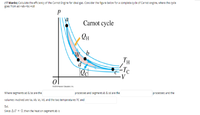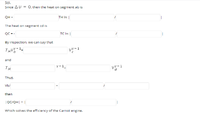Question

Transcribed Image Text:(17 blanks) Calculate the efficiency of the Carnot Engine for ideal gas. Consider the figure below for a complete cycle of Carnot engine, where the cycle
goes from ad->ab->bc->cd
Carnot cycle
TH
-Tc
V
2016 Pearson Education, Inc.
processes; and the
Where segments ad & bc are the
processes and segment ab & cd are the
valumes involved are Va, Vb, Vc, Vd, and the two temperatures TC and
Sol.
Since AU = 0, then the heat on segment ab is

Transcribed Image Text:Sol.
Since A U =
O, then the heat on segment ab is
QH =
TH In |
The heat on segment cd is
QC = -
TC In
By inspection, we can say that
THV-
vr-1
and
TH
Y-1
vr-1
Thus.
Vb/
then
|Qc/QH|
=
Which solves the efficiency of the Carnot engine.
Expert Solution
This question has been solved!
Explore an expertly crafted, step-by-step solution for a thorough understanding of key concepts.
This is a popular solution
Trending nowThis is a popular solution!
Step by stepSolved in 2 steps with 2 images

Knowledge Booster
Similar questions
- As shown in the figure, a chamber with a moveable piston and containing a monatomic ideal gas in an initial state A undergoes an isovolumetric, then an isothermal, and finally an isobaric process to complete the cycle. P (atm) LV (L) When the gas is in the initial state, the volume is 3.00 L, the pressure is 5.00 atm, and the temperature is 200 K. The gas is first warmed at constant volume to a pressure of 4 times the initial value (state B). The gas is then allowed to expand isothermally to some new volume (state C). Finally it is compressed isobarically to its initial state. (Due to the nature of this problem, do not use rounded intermediate values in your calculations-including answers submitted in WebAssign.)arrow_forwardCalculate the net work output of a heat engine following path ABCDA in the figure below, where V1 = 2.6 ✕ 10−3 m3 and V2 = 10.4 ✕ 10−3 m3.arrow_forwardCalculate the efficierncy of a Carnot reversible heat engine working between the temperatures 127 degree C- (-73 degree C).arrow_forward
- Question 1arrow_forward9-59E An ideal dual cycle has a compression ratio of 15 and a cutoff ratio of 1.4. The pressure ratio during constant- volume heat addition process is 1.1. The state of the air at the beginning of the compression is P =14.2 psia and T, = 75°F. Calculate the cycle's net specific work, specific heat addition, and thermal efficiency. Use constant specific heats at room temperature. %3Darrow_forward
arrow_back_ios
arrow_forward_ios